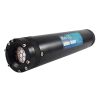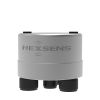Pro-Oceanus Solu-Blu Dissolved CO2 Probe
Features
- Provides continuous 24/7 CO2 monitoring
- Fully temperature and pressure compensated
- User-input salinity values allow for automatic salinity correction
- Expedited repair and warranty service
- Lifetime technical support
- More
Overview
The Pro-Oceanus Solu-Blu dissolved CO2 probe can be used for long-term continuous in-situ monitoring to provide reliable free dissolved carbon dioxide data. The probe provides a fully temperature and pressure compensated free dissolved CO2 and partial pressure of CO2, and user-input salinity values allow for automatic salinity correction. Flow-through and in-line adapters are also available for simple and effective industrial solutions.
Mechanics
Combines rugged design, ease of use and versatility, all in a single sensor package. The measurement of a gas dissolved in a liquid is facilitated by a semi-permeable membrane that allows gases to transfer from water into a gas head space where the measurement is made.
| Sensor Performance | |
|---|---|
| CO2 Measurement Ranges | 0-50 mg/L 0-2000 μatm 0-5000 μatm 0-10,000 μatm *other ranges available |
| Accuracy | |
| CO2 | ± 3% of max range |
| TDGP | ± 0.1% (0-2 bar range) |
| Temperature | ± 0.5º C |
| Equilibration rate (t63): | |
| pCO2 | 4 minutes |
| TDGP | 10 minutes |
| Sensor warm up time | 3 minutes |
| Resolution pCO2 | 0.1% of max range |
| Physical | |
|---|---|
| Length | 20 cm (8 in) 26 cm with connector |
| Diameter | 5 cm (2 in) |
| Weight | 0.28 kg (0.6 lbs) |
| Housing Material | Acetal Plastic |
| Depth Rating | 0 - 50 meters |
| Water Temperature | -2º to 40º C |
| Electrical | |
|---|---|
| Input voltage |
digital: 6-24 VDC |
| Power consumption | 0.45 W (35 mA @ 12 V) |
| Data output | RS-232, ASCII format 0-5 V or 4-20 mA |
| Sample rate | 1 second |
In The News
Spring 2025 Environmental Monitor Available Now
In the Spring 2025 edition of the Environmental Monitor, we highlight partnerships across the world and the importance of collaboration between government agencies, universities, environmental groups, local communities, and other stakeholders. From great white shark research in Cape Cod to monitoring fisheries in Lake Erie, this latest edition underscores partnerships that connect stakeholders in a watershed through environmental data. With an emphasis on data sharing, a combination of real-time and discrete sampling keeps the public and partners informed of environmental conditions. Our writers also sought out science professionals dedicated to working with peers within and outside of the environmental sector.
Read MoreMonitoring Mariculture in the Gulf of Alaska
The mariculture industry in the Gulf of Alaska has been steadily growing in recent years, guided by ongoing research to help refine farm location and cultivation practices. A subset of aquaculture, mariculture focuses on rearing organisms in the open ocean. In Alaska, finfish farming is illegal, so most farms cultivate kelp, oysters, or a combination of the two. These small, locally operated farms started popping up in the Gulf of Alaska in the early 1990s, when shellfish farming first became legal. Kelp farming did not begin to catch on in the state until 2016. Many of the coastal areas that have grown interested in mariculture are historically commercial fishing communities.
Read MoreSupplying Seattle’s Drinking Water: Using Data Buoys to Monitor the Cedar River Municipal Watershed
Providing clean, safe, and reliable drinking water for the 1.6 million people in the greater Seattle area is a top priority for Seattle Public Utilities (SPU). With limited water supplies, SPU dedicates considerable resources to maintain its watersheds and mountain reservoirs. About 70 percent of Seattle Water comes from the Cedar River Municipal Watershed , and the other 30 percent comes from the South Fork Tolt River Watershed . [caption id="attachment_39574" align="alignnone" width="940"] Data buoy in Chester Morse Lake . (Credit: Kevin Johnson / Seattle Public Utilities) [/caption] Jamie Thompson, a fisheries biologist at SPU, monitors aquatic ecosystems centered on fish listed under the U.S. Endangered Species Act (ESA).
Read More

















